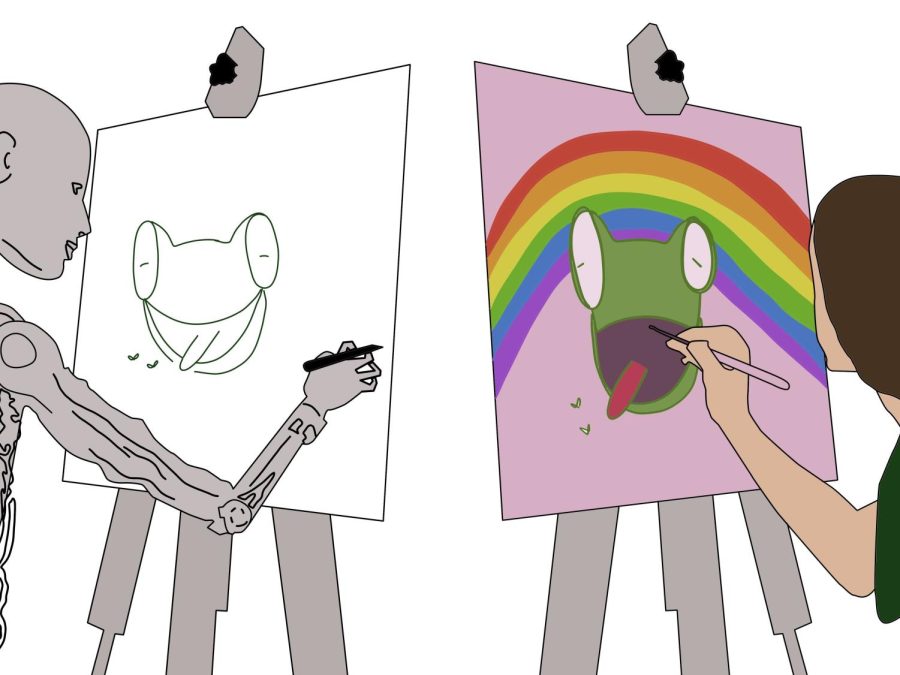Professors say AI art advancements shouldn’t worry art students at Northeastern
March 1, 2023
The booming technology of artificial intelligence, or AI, and its ability to create images at the click of a button has sent a chill down the backs of art and design students, not only at Northeastern but across the world.
“We’re trying to innovate as much as possible, but AI art is setting that back,” said Tori Thorp, a first-year journalism and interaction design combined major. “If more and more companies start to use AI art… design won’t be as experience-centric. It will be very centered on the past and what has already been made.”
AI art frustrates artists like Thorp because they feel companies may choose profit over quality of design.
“I used to do a lot of commissions of portraits. I don’t really do that anymore,” Thorp said, recollecting how the invention of AI art has impacted her personally. “The commissions that I get now are all album covers or scenes that AI [can’t] create as well. There’s less of a demand for portraits, I guess.”
Already, advancements in AI art have begun to decrease demand for artists.
We know the product of these systems, but how do they actually work?
AI art generators function using self-learning algorithms. The systems are made up of two competing algorithms, the “generator” and the “discriminator.” One system is trained for image recognition, while the other generates images, trying to trick the other system into believing the image is real. Both systems train each other, improving the generator’s capabilities.
The pushback from artists is directed at both the AI’s capability to produce art at a much cheaper rate, as well as the process by which these systems collect images for program training. Images are scraped from the internet and used in the data training process, regardless of whether an artist has given their expressed consent or not.
“It steals art,” Thorp said. “You [can] see sometimes the mangled remains of a signature in the corner. So, it’s very obvious that it steals art from artists to create these things.”
However, two professors at Northeastern have a different perspective. Despite growing concerns within the art community, Derek Curry and Jennifer Gradecki, Northeastern associate professors specializing in artistic production and socio-technical systems, believe the growth of AI art will open new doorways for artists and programmers alike.
Curry compared the path of AI art to photography. He believes AI will free artists from having to create realistic or generic images, instead giving them liberty to focus on more creative and unique projects.
“For a while, there were artists who were hired to paint murals and signs for buildings. Now, if you want a billboard put up, you don’t hire someone to paint it by hand — you have it printed out,” Curry told The News. “During that moment, there was this question of ‘Oh what are all these young artists gonna do for a living?’ They ended up doing web design or something like that. … It just means that art is changing and evolving, which is always happening.”
While change is a constant in the arts, AI art creation has had resoundingly negative feedback from the artist community. The perception of AI is strange to many because the creation of AI art lacks a human touch.
“The entire nature of art is progressive. It’s very experience-centered,” Thorp said. “I think that AI, no matter what, can’t replicate that progressive nature of art because it’s always dipping into the past for its information.”
Gradecki agreed human artists are necessary in the creation of AI art.
“The way that we see these tools is just that — tools for artists to co-create with, to collaborate with,” Gradecki said. “But the artist is ultimately still making all the editorial decisions. All the conceptual dimensions are coming from the artist.”
Although AI art may not be as successful without human co-creation, artists like Thorp still fear it may take several years for some companies to realize the resounding benefits of utilizing human artistic expression.
Despite the fears of some students, Gradecki and Curry maintain that students will continue to have a vast array of opportunities.
“I think at Northeastern, there’s actually going to be more opportunities rather than fewer. We just started a minor in creative computing,” Curry said. “What the students found quickly was it wasn’t just this plug-and-play kind of thing. It takes a long time to get [an AI program] to do something good or something that you want [it] to [do].”
According to Curry, working with these algorithms is an art in itself, and companies are likely to find out sooner rather than later that there is a high level of skill required to generate a desired product.
Similarly, Gradecki believes AI art generators will steer an artist’s role in the creation process in a different direction.
“I think Northeastern is really preparing students for those kinds of fields and we are really building the creative computing area in order to do that,” Gradecki said. “So that artists can think both critically and creatively through these technologies.”
AI art still brings up many ethical concerns regarding the collection process of data and the lack of consent from artists. However, Northeastern appears to be taking steps to prepare students for the ever-changing field of art creation.


















